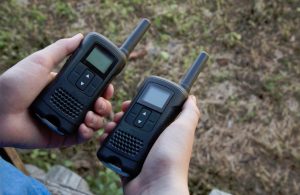
Part of owning a walkie-talkie is knowing if the specific type you have is legal in the country you’re in. This allows you to pick the radio you need assuringly, knowing that you won’t get in trouble with the law.
In other words, before checking out some of the best Bluetooth walkie talkies, make sure you’re allowed to use them in your part of the world. Whether or not a particular radio will work in your neck of the woods typically isn’t a concern; chances are, it will. Instead, what you need to concern yourself with are the laws that surround walkie-talkie usage.
Today, we’ll talk about some regulations on radio use, most of which involve how specific types of radios should be used legally.
Page Contents
The Legal Use of Radios Around the World
Depending on where you live, governments may have specified the types of handheld transceivers that the general public can purchase and use legally for specific purposes. We know you’re itching to get your hands on that two-way radio to make distance communication more accessible. Before you do, let’s first find out if you’re even allowed to use them in your home nation.

The United Kingdom
The United Kingdom abides by the PMR446, which is the European Union standard for two-way radio use. The 446 stands for the 446 MHz frequency of all its eight channels, all of which have a two-mile maximum range in open country.
Radios classified under PMR446 are not allowed to have transmission power greater than 500mW, making all models hold the same max range. The Lynx PT400, Entel HX446L, Kirisun PT558, and Cobra radios comply with the PMR446 European standard. However, they aren’t approved for use in Canada or the United States.
Additionally, the voltage range in Europe is 230 to 240. Therefore, the 120V American chargers won’t likely do these radios any good.
United States
The USA follows either the FRS or GMRS standard for their consumer radios, which are sold in almost all US states. Both have a combined 14 to 22 channels across frequencies, ranging from 462 MHz to 467 MHz. These radios aren’t allowed to connect with their European PMR446 counterparts and are illegal to use in Europe.
Besides, mains voltage in Canada and the US is at 120v. As such, you could have problems using US-conforming radios in Europe and the United Kingdom, given their 240-voltage requirement. EU voltage could literally blow up those 120V American chargers. Therefore, it’s not just your legal freedom you’re risking but also your life when you attempt this unlawful move.
Lawfully speaking, a combined European-American walkie-talkie does not exist. That’s because usage of either one is restricted to either America or Europe. There’s also the fact that intercontinental transmission would imply transmission of illegal frequencies, which could get you in trouble in either location.
An EU PMR446 cannot be modified to meet the FRS-GMRS American standard and vice versa. However, a non-PMR446 radio is another story, as their frequencies can usually be altered to meet the US standard.
The Rest of the World
As far as the rest of the globe is concerned, individual regulations still apply regarding the types of radios that can be used legally. That means it’s up to the prospective buyer to go over the rules governing radio use for their specific country.
For instance, the Middle East can be especially strict about their radio usage policies, including what types of radios can be brought within their borders. Failure to comply with their rules could result in radios being confiscated by customs personnel.
Meanwhile, the rest of Europe doesn’t seem to be too worried about the kinds of radios that make it to their land. Of course, rule-stickler Switzerland is the exception to this, and for good reason.
Can You Use a Two-Way Radio While Driving?
Yes, you may use a handheld transceiver while driving, provided that it doesn’t interfere with the activity in any way. That said, there are stipulations attached to that answer. Basically, a two-way radio user should be aware of the following:
- Using two-way radios for the purpose of sending and receiving voice messages is considered an offense.
- Using these transceivers in frequencies other than those within the 880 MHz to 2170 MHz ranges is also considered unlawful.
- Operating within the 27 MHz band is also considered illegal for two-way radios used for driving. That’s because these frequency bands are meant to be used as government communication channels and not general public ones.
So, Is It Illegal To Use a Walkie-Talkie?
Ultimately, that would depend on the walkie-talkie, your purpose, and the country you’re using it in. Buying a two-way radio means researching how to use it legally where you’re at. After all, the last thing you want is to get in trouble for communicating illegally without even knowing. Not only would this be irresponsible, but it would also be embarrassing.
Spend some time while cruising the options. Here’s what to look for in a walkie-talkie!
Walkie-talkies are great for many situations, from communicating with your hunting friends to staying in touch when skiing with the family. These rugged, compact, and lightweight devices are versatile and helpful in many activities. As the market gives you many models covering a wide range of prices, we recommend you spend some time with research work before buying. Don’t rush into buying the first model you see on shelves, as you might end up with a lemon. It’s helpful to check out the following aspects before placing your order.
From wattage to range of cover and size, there are so many details to examine before buying your walkie-talkies carefully.
Size and weight
Factors such as size, weight, and shape are crucial to consider, especially if you’re using the devices in outdoor activities (backpacking, hiking, hunting, etc.). If so, we suggest you look for lightweight devices with a slim profile. If you go mountaineering or skiing, walkie-talkies with the ergonomic shape and a good grip for effortless use when hand-gloved are ideal. Look for a unit with an antenna as long as the unit’s body. It’s one feature that ensures the unit has enough power for your activities.
Range of coverage and wattage
When you look for walkie-talkies, you will run into models with a range of up to 25 miles. Of course, we’re talking about optimal conditions. However, conditions in real life are rarely ideal; most of the time, expect your walkie-talkie’s range to be around 2 miles or even less than that.
An FRS-only model will need a half-watt and provide you with a range up to 6 miles. Even if GMRS ensures a maximum power output of 50 watts, the models for recreational use will give only 1 or 2 watts—it’s because they have to remain lightweight and relatively small. Such models will cover a range between 8 to 25 miles. We care to highlight the units giving more power are used for base stations.
Sure enough, a high-powered unit (1 or 2-watt models) can cover dropouts (when you’re in buildings or behind hills) that happen within your light of sight. High power will enhance the overall quality of the signal.
Also, high-watt radios use more battery power and are pricier, so make sure you need this sort of device. Get one if you need range more than you need battery life. Low-watt FRS models are just as reliable if you only need walkie-talkies to communicate with your family while hiking/skiing, etc.
Two-way radio channels
Most radio, especially units made for outdoor activities, come with 22 channels, on the General Mobile Radio Service (GMRS) or the Family Radio Service (FRS). We want to warn you that you need a 10-year license from the FCC to use a radio using GMRS channels.
Privacy/interference-eliminator codes
If you plan on using your walkie-talkie in a ski resort, you will discover that it doesn’t take long until 22 channels are taken. In such situations, it’s common for radios to ensure a Continuous Tone Coded Squelch System (CTCSS) or CDCSS (Continuous Digital Coded Squelch System) so that you can use a busy primary channel with the help from privacy codes. Instead of struggling to reach your friend by using Channel 5, you can contact him through the privacy codes. They allow you to connect with a combination of codes and channels—Channel 5 and Code 3 is good example.
Using the CTCSS and CDCSS codes will not eliminate the amount of unpleasant small talk on the primary channel. However, it will significantly reduce the quantity of unwanted chatter.
We want to remind you that “privacy codes” don’t make your communication private in any way. For this reason, some manufacturers name the feature “interference-elimination” code, which is more appropriate.
Other features
Scanning
Thanks to this feature, you will be able to navigate through channels until you discover the one your group is using. Should you want to identify fast and easy an “empty” channel for your group to use, the scanning feature is the one to operate on your walkie-talkie.
Calling&paging functions
When you pre-set the “calling” tones, you can quickly draw other friends’ attention in your group before you begin talking. Some models allow you to set the functions on vibration, not on audible tone, which can be annoying.
Noise filter
This feature will let you clear signals and improve the range.
Keypad lock
When you have a model with a keypad lock, you will lock the settings so that you don’t change them by accident. It’s a great feature, primarily if you use your walkie-talkie for energetic outdoor activities.
Hands-free
Hands-free operation is an excellent thing if you use your walkie-talkie while skiing or hiking. Anything on your walkie-talkie providing you with hands-free operation is valuable. Jacks for microphones, headphones, and microphone/headphone combos are ideal in this way. If you plan to use the walkie-talkie for kayaking, skiing, cycling, etc., such features are worth the extra buck on any given day.
Weather radio
When you use your walkie-talkie for outdoor activities, you want to stay updated on the forecast and weather conditions. We all know how quickly the weather changes when you’re in the mountains. With Weather radio, you only need to tap into the NOAA weather band stations to update weather.
VOX
The Voice-activated feature (VOX) starts broadcasting automatically when you talk in the direction of the radio, thus allowing hands-free operation. It’s another excellent feature that skiers and mountain bikers go for in their walkie-talkies.
Radio/GPS combo units
Some units come with all-in-one nav/comm ability. The most significant benefit is that you get peer-to-peer positioning so you can broadcast your location coordinates. It will be a piece of cake for your fellow users to see the coordinates on their screens. Needless to say, you will have to open your wallet big for such models.
Two-way radio batteries
AA and AAA batteries are most commonly used for running two-way radios. Many models are made to take disposable alkaline batteries and allow rechargeable nickel-metal hydride (NIMH)batteries. Walkie-talkies that come with their rechargeable battery packs are available as well.
Texting/GPS units
Such units are complex as they let you listen and talk and exchange messages with other users. They are easy to connect to your cell phone and can also transmit your GPS location.
Frequently Asked Questions
Is it possible to use a walkie-talkie underground?
Mother-Earth is so generous with us and gives us so many amazing places to discover! Caves are such places that many people find interesting. You shouldn’t worry very much if you plan on exploring some caves on your own. However, when it comes to nature, we can never be too sure and the risk for accidents is never null. If you like to explore caves, you must be aware of the reality that walkie-talkies and cell phones won’t work underground.
Is your conversation private on a walkie-talkie?
Luckily for walkie-talkie users, the communications can be private. Sending encrypted message is the only way to make sure that nobody buy you and your friends get the messages. Keep in mind that this function isn’t available for all models. Should you care deeply for your conversation to stay private, you need to buy an encryption features model.
Can use a walkie-talkie affect your health?
As long as the circumstances aren’t harmful in any way, using a walkie-talkie won’t harm your body in any way. It’s not the same with high-power models, such as those using a 10W power. Such units will generate 20 times the radiation value of a mobile phone. Such radiation will harm your body, so be cautious when using them.
We’ve seen it in the movies, but can you really pick up police on a walkie-talkie?
Most average walkie-talkies (FRS or GMRS) won’t be able to pick up police conversations. It doesn’t mean, though, that you cannot find ways to listen to police radio. Should you be interested in such activities, you will need a police scanner that helps you pick up police chatter. With such devices, you can also listen to air traffic, EMS, fire, and other channels that allow you do your job.
Will you get a fine for using a walkie-talkie while driving?
As long your driving doesn’t suffer in any way when you use a walkie-talkie, it’s safe and legal to use one. We care to highlight that this is the short answer as some details of the scenario of you utilizing a walkie-talkie come into play. The chances for you to get a fine for using a walkie-talkie when driving aren’t null, so make sure your circumstances require the use.









